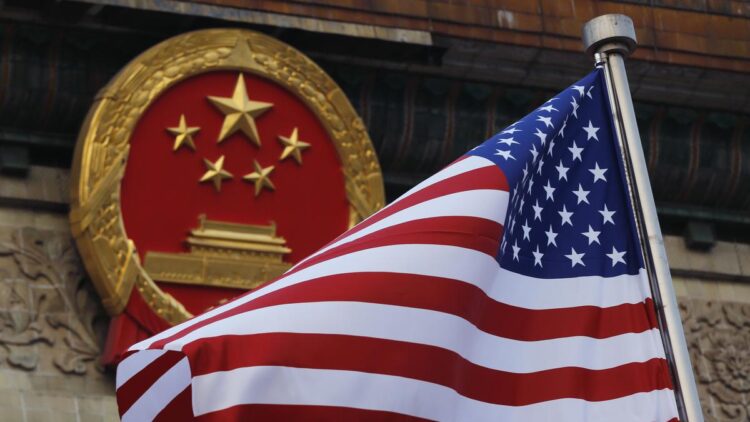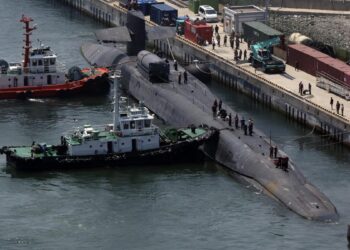[ad_1]
What in the world is that thing? A massive white orb sweeping across U.S. airspace has triggered a diplomatic maelstrom and is blowing up on social media.
China insists it’s just an errant civilian airship used mainly for meteorological research that went off course due to winds. With only limited “self-steering” capabilities.
However, the U.S. says it’s a Chinese spy balloon without a doubt. And its presence prompted Secretary of State Antony Blinken to cancel a weekend trip to China that was aimed at dialing down tensions that were already high between the countries.
The Pentagon says the balloon, which is carrying sensors and surveillance equipment, is maneuverable and has shown it can change course. It has loitered over sensitive areas of Montana where nuclear warheads are siloed, prompting the military to take actions to prevent it from collecting intelligence.
A Pentagon spokesman said it could remain aloft over the U.S. for “a few days,” extending uncertainty about where it will go or if the U.S. will try to safely take it down.
A look at what’s known about the balloon — and what isn’t.
It’s a bird, it’s a plane, it’s a… balloon
The Pentagon and other U.S. officials say it’s a Chinese spy balloon — about the size of three school buses — moving east over America at an altitude of about 60,000 feet (18,600 meters). The U.S. says it was being used for surveillance and intelligence collection, but officials have provided few details.
U.S. officials says the Biden administration was aware of it even before it crossed into American airspace in Alaska early this week. A number of officials spoke on condition of anonymity to discuss the sensitive topic.
The White House said that President Joe Biden was first briefed on the balloon on Tuesday. And the State Department said Blinken and Deputy Secretary Wendy Sherman spoke with China’s senior Washington-based official on Wednesday evening about the matter.
In the first public U.S. statement, Brig. Gen. Pat Ryder, Pentagon press secretary, said Thursday evening that the balloon was not a military or physical threat — an acknowledgement that it was not carrying weapons. And he said that “once the balloon was detected, the U.S. government acted immediately to protect against the collection of sensitive information.”
Even if it’s not armed, the balloon poses a risk to the U.S., says retired Army Gen. John Ferrari, a visiting fellow at the American Enterprise Institute. The flight itself, he said, can be used to test America’s ability to detect incoming threats and to find holes in the country’s air defense warning system. It may also allow the Chinese to sense electromagnetic emissions that higher-altitude satellites can’t detect, such as low-power radio frequencies that could help them understand how different U.S. weapons systems communicate.
He also said the Chinese may have sent the balloon “to show us that they can do it, and maybe next time it could have a weapon. So now we have to spend money and time on it” developing defenses.
Let it fly? Shoot it down?
According to senior administration officials, President Joe Biden initially wanted to shoot the balloon down. And some members of Congress have echoed that sentiment.
But top Pentagon leaders strongly advised Biden against that move because of risks to the safety of people on the ground, and Biden agreed.
One official said the sensor package the balloon is carrying weighs as much as 1,000 pounds. And the balloon is large enough and high enough in the air that the potential debris field could stretch for miles, with no control over where it would eventually land.
For now, officials said the U.S. will monitor it, using “a variety of methods” including aircraft. The Pentagon also has said the balloon isn’t a military threat and doesn’t give China any surveillance capabilities it doesn’t already have with spy satellites.
But the U.S. is keeping its options open and will continue to monitor the flight.
Rep. Jim Himes, the top Democrat on the House Intelligence Committee, suggested that it could be valuable to try and capture the balloon to study it. “I would much rather own a Chinese surveillance balloon than be cleaning one up over a 100-square-mile debris field,” Himes said.
How did it get there?
Deliberate or an accident? There’s also disagreement.
As far as wind patterns go, China’s account that global air currents — winds known as the Westerlies — carried the balloon from its territory to the western United States is plausible, said Dan Jaffe, a professor of atmospheric chemistry at the University of Washington. Jaffe has studied the role those same wind patterns play in carrying air pollution from Chinese cities, wildfire smoke from Siberia and dust from Gobi Desert sand storms to the U.S. for two decades.
“It’s entirely consistent with everything we know about the winds,” Jaffe said. “Transit time from China to the United States would be about a week.” “The higher it goes, the faster it goes,” Jaffe said. He said that weather and research balloons typically have a range of steering capability depending on their sophistication, from no steering at all to limited steering ability.
The U.S. is largely mum on this issue, but insists the balloon is maneuverable, suggesting that China in some way deliberately moved the balloon toward or into U.S. airspace.
History of spy balloons
Spy balloons aren’t new — primitive ones date back centuries, but they came into greater use in World War II. Administration officials said Friday that there have been other similar incidents of Chinese spy balloons, with one saying it happened twice during the Trump administration but was never made public.
At the Pentagon, Ryder confirmed there have been other incidents where balloons came close to or crossed over the U.S. border, but he and others agree that what makes this different is the length of time it’s been over U.S. territory and how far into the country it penetrated.
Craig Singleton, a senior fellow at the Foundation for the Defense of Democracies, said Chinese surveillance balloons have been sighted on numerous occasions over the past five years in different parts of the Pacific, including near sensitive U.S. military installations in Hawaii. The high altitude inflatables, he said, serve as low-cost platforms to collect intelligence and some can reportedly be used to detect hypersonic missiles.
During World War II, Japan launched thousands of hydrogen balloons carrying bombs, and hundreds ended up in the U.S. and Canada. Most were ineffective, but one was lethal. In May 1945, six civilians died when they found one of the balloons on the ground in Oregon, and it exploded.
In the aftermath of the war, America’s own balloon effort ignited the alien stories and lore linked to Roswell, New Mexico.
According to military research documents and studies, the U.S. began using giant trains of balloons and sensors that were strung together and stretching more than 600 feet as part of an early effort to detect Soviet missile launches during the post-World War II era. They called it Project Mogul.
One of the balloon trains crash-landed at the Roswell Army Airfield in 1947, and Air Force personnel who were not aware of the program found debris. The unusual experimental equipment made it difficult to identify, leaving the airmen with unanswered questions that over time —aided by UFO enthusiasts — took on a life of their own. The simple answer, according to the military reports, was just over the Sacramento Mountains at the Project Mogul launch site in Alamogordo.
In 2015, an unmanned Army surveillance blimp broke loose from its mooring at Aberdeen Proving Ground in Maryland and floated over Pennsylvania for hours with two fighter jets on its tail, triggering blackouts as it dragged its tether across power lines. As residents gawked, the 240-foot blimp came down in pieces in the Muncy, Pennsylvania, countryside. It still had helium in its nose when it fell, and state police used shotguns — about 100 shots — to deflate it.
[ad_2]
[ad_1]
What in the world is that thing? A massive white orb sweeping across U.S. airspace has triggered a diplomatic maelstrom and is blowing up on social media.
China insists it’s just an errant civilian airship used mainly for meteorological research that went off course due to winds. With only limited “self-steering” capabilities.
However, the U.S. says it’s a Chinese spy balloon without a doubt. And its presence prompted Secretary of State Antony Blinken to cancel a weekend trip to China that was aimed at dialing down tensions that were already high between the countries.
The Pentagon says the balloon, which is carrying sensors and surveillance equipment, is maneuverable and has shown it can change course. It has loitered over sensitive areas of Montana where nuclear warheads are siloed, prompting the military to take actions to prevent it from collecting intelligence.
A Pentagon spokesman said it could remain aloft over the U.S. for “a few days,” extending uncertainty about where it will go or if the U.S. will try to safely take it down.
A look at what’s known about the balloon — and what isn’t.
It’s a bird, it’s a plane, it’s a… balloon
The Pentagon and other U.S. officials say it’s a Chinese spy balloon — about the size of three school buses — moving east over America at an altitude of about 60,000 feet (18,600 meters). The U.S. says it was being used for surveillance and intelligence collection, but officials have provided few details.
U.S. officials says the Biden administration was aware of it even before it crossed into American airspace in Alaska early this week. A number of officials spoke on condition of anonymity to discuss the sensitive topic.
The White House said that President Joe Biden was first briefed on the balloon on Tuesday. And the State Department said Blinken and Deputy Secretary Wendy Sherman spoke with China’s senior Washington-based official on Wednesday evening about the matter.
In the first public U.S. statement, Brig. Gen. Pat Ryder, Pentagon press secretary, said Thursday evening that the balloon was not a military or physical threat — an acknowledgement that it was not carrying weapons. And he said that “once the balloon was detected, the U.S. government acted immediately to protect against the collection of sensitive information.”
Even if it’s not armed, the balloon poses a risk to the U.S., says retired Army Gen. John Ferrari, a visiting fellow at the American Enterprise Institute. The flight itself, he said, can be used to test America’s ability to detect incoming threats and to find holes in the country’s air defense warning system. It may also allow the Chinese to sense electromagnetic emissions that higher-altitude satellites can’t detect, such as low-power radio frequencies that could help them understand how different U.S. weapons systems communicate.
He also said the Chinese may have sent the balloon “to show us that they can do it, and maybe next time it could have a weapon. So now we have to spend money and time on it” developing defenses.
Let it fly? Shoot it down?
According to senior administration officials, President Joe Biden initially wanted to shoot the balloon down. And some members of Congress have echoed that sentiment.
But top Pentagon leaders strongly advised Biden against that move because of risks to the safety of people on the ground, and Biden agreed.
One official said the sensor package the balloon is carrying weighs as much as 1,000 pounds. And the balloon is large enough and high enough in the air that the potential debris field could stretch for miles, with no control over where it would eventually land.
For now, officials said the U.S. will monitor it, using “a variety of methods” including aircraft. The Pentagon also has said the balloon isn’t a military threat and doesn’t give China any surveillance capabilities it doesn’t already have with spy satellites.
But the U.S. is keeping its options open and will continue to monitor the flight.
Rep. Jim Himes, the top Democrat on the House Intelligence Committee, suggested that it could be valuable to try and capture the balloon to study it. “I would much rather own a Chinese surveillance balloon than be cleaning one up over a 100-square-mile debris field,” Himes said.
How did it get there?
Deliberate or an accident? There’s also disagreement.
As far as wind patterns go, China’s account that global air currents — winds known as the Westerlies — carried the balloon from its territory to the western United States is plausible, said Dan Jaffe, a professor of atmospheric chemistry at the University of Washington. Jaffe has studied the role those same wind patterns play in carrying air pollution from Chinese cities, wildfire smoke from Siberia and dust from Gobi Desert sand storms to the U.S. for two decades.
“It’s entirely consistent with everything we know about the winds,” Jaffe said. “Transit time from China to the United States would be about a week.” “The higher it goes, the faster it goes,” Jaffe said. He said that weather and research balloons typically have a range of steering capability depending on their sophistication, from no steering at all to limited steering ability.
The U.S. is largely mum on this issue, but insists the balloon is maneuverable, suggesting that China in some way deliberately moved the balloon toward or into U.S. airspace.
History of spy balloons
Spy balloons aren’t new — primitive ones date back centuries, but they came into greater use in World War II. Administration officials said Friday that there have been other similar incidents of Chinese spy balloons, with one saying it happened twice during the Trump administration but was never made public.
At the Pentagon, Ryder confirmed there have been other incidents where balloons came close to or crossed over the U.S. border, but he and others agree that what makes this different is the length of time it’s been over U.S. territory and how far into the country it penetrated.
Craig Singleton, a senior fellow at the Foundation for the Defense of Democracies, said Chinese surveillance balloons have been sighted on numerous occasions over the past five years in different parts of the Pacific, including near sensitive U.S. military installations in Hawaii. The high altitude inflatables, he said, serve as low-cost platforms to collect intelligence and some can reportedly be used to detect hypersonic missiles.
During World War II, Japan launched thousands of hydrogen balloons carrying bombs, and hundreds ended up in the U.S. and Canada. Most were ineffective, but one was lethal. In May 1945, six civilians died when they found one of the balloons on the ground in Oregon, and it exploded.
In the aftermath of the war, America’s own balloon effort ignited the alien stories and lore linked to Roswell, New Mexico.
According to military research documents and studies, the U.S. began using giant trains of balloons and sensors that were strung together and stretching more than 600 feet as part of an early effort to detect Soviet missile launches during the post-World War II era. They called it Project Mogul.
One of the balloon trains crash-landed at the Roswell Army Airfield in 1947, and Air Force personnel who were not aware of the program found debris. The unusual experimental equipment made it difficult to identify, leaving the airmen with unanswered questions that over time —aided by UFO enthusiasts — took on a life of their own. The simple answer, according to the military reports, was just over the Sacramento Mountains at the Project Mogul launch site in Alamogordo.
In 2015, an unmanned Army surveillance blimp broke loose from its mooring at Aberdeen Proving Ground in Maryland and floated over Pennsylvania for hours with two fighter jets on its tail, triggering blackouts as it dragged its tether across power lines. As residents gawked, the 240-foot blimp came down in pieces in the Muncy, Pennsylvania, countryside. It still had helium in its nose when it fell, and state police used shotguns — about 100 shots — to deflate it.
[ad_2]
















